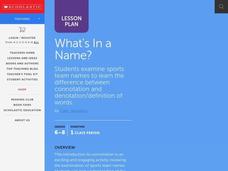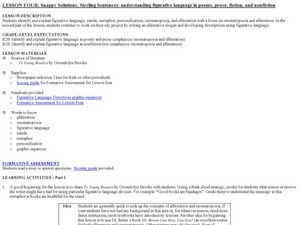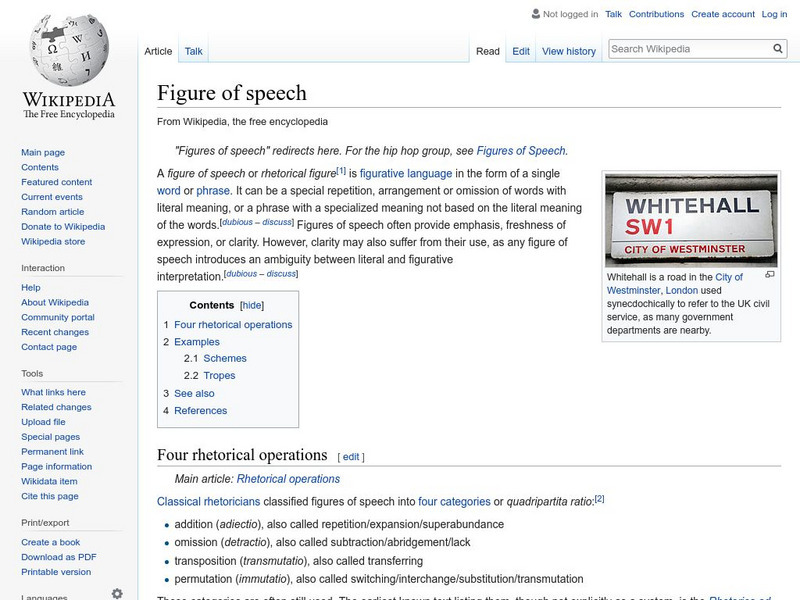Spelling City
Card Flip Game: Synonyms and Antonyms
Match words to their synonyms and antonyms with a card flip game. Kids turn over two cards on their turn and determine if they are synonyms or antonyms; if not, they replace the cards and try again.
Curated OER
Figurative Language
Play a figurative language game! Starting with a review of terms, this presentation quickly launches into a quiz game with hyper-linked answers. Simply click an answer to find out if it's wrong or right. The option to try again is always...
Curated OER
1984 by George Orwell
Readers of Nineteen Eighty-Four engage in a close reading exercise that directs their focus to the key details Orwell provides in the opening paragraphs to introduce his dystopian society. The included worksheeet is divided into three...
Curated OER
How to Identify Figurative Language
Reinforce understanding of five literary terms with a single-slide flow chart. Learners figure out if various words and phrases are examples of simile, metaphor, hyperbole, understatement, or personification.
Curated OER
Reading Poetry in the Middle Grades
Bring the beauty of "Nothing Gold Can Stay" by Robert Frost to middle school language arts. After learners read a copy of the poem, they follow an instructional sequence that focuses on sound, figurative language, and theme.
Curated OER
Figurative Language - Figuring it Out
Play this slide show and then find out how much your class has learned with the included quiz. After jotting down the definitions of each term, class members label 10 examples with one of five terms: simile, metaphor, personification,...
Southern Illinois University
I Can Write a Poem
It is so important for English language learners to be able to write for a variety of purposes. Specifically written for an ELD class, this activity provides explicit instruction for teaching learners how to write a poem. First, they...
Curated OER
“The Story of an Hour” Extension Activities: Teacher’s Guide and Notes
Enhance and extend instruction of "The Story of an Hour" by Kate Chopin with one or all of these ideas. You might want to cover characterization and summary, or improve understanding of context clues and irony. You can cover any...
Curated OER
Leveled Vocabulary for And Then There Were None
Chaotic, perjury, tenacious, vague, predatory, idiosyncrasy. Using Marzano and Brown’s six steps of direct instruction for vocabulary (choose, restate, illustrate, use, discuss, play) readers of And Then There Were None engage in a...
Curated OER
Persuasion in Historical Context: The Gettysburg Address
The Gettysburg Address is a powerful text. Use it to teach persuasion and the importance of word choice. The activity detailed here includes a scaffolded background knowledge activity that includes image analysis of photos from the Civil...
Curated OER
Ethos, Logos, and Pathos in Civil Rights Movement Speeches
Examine three speeches while teaching Aristotle's appeals. Over the course of three days, class members fill out a graphic organizer about ethos, pathos, and logos, complete an anticipatory guide, read speeches by Martin Luther King Jr.,...
Curated OER
Connotation and Denotation: How Word Choice Affects a Paragraph
Review the terms denotation, connotation, diction, and mood in paragraph writing. After defining the terms, middle schoolers practice writing examples of both connotation and denotation. They complete a connotation and denotation graphic...
Curated OER
What's In a Name?
Introduce your language arts class to connotation, denotation, and diction. Middle schoolers identify and differentiate between the connotative and denotative meanings of words by analyzing the fictitious sports team names. Learners...
Curated OER
Analyzing Literary Devices
Eighth graders identify figurative language and poetry in this literary analysis lesson. Using Through the Looking Glass by Lewis Carroll and a YouTube video for "The Walrus and the Carpenter," young readers complete a literary device...
9/11 Memorial & Museum
Exploring Afghani Culture through Literature
Hosseini Khaled's The Kite Runner and A Thousand Splendid Suns are the anchor texts in a semester-long course that explores Afghani culture and traditions.
K12 Reader
Choose the Correct Homophone
It's a known secret that English can be a difficult language to learn, and homophones don't make it any easier. Help your young readers tackle these tricky words with this simple fill-in-the blank exercise in which they identify the word...
Curated OER
All Summer in a Day Vocab
While working with Ray Bradbury's "All Summer in a Day," take some time to consider vocabulary. This exercise lists eight sentences from the story in which Bradbury uses words in interesting or different ways. Pupils read the sentence...
Mailbox Education Center
On the Hunt: Understanding Figurative Language
Young writers hunt for examples of figurative language in their reading. The hunt requires pupils to cite their sources, record a quoted example for each type of figurative language, and an explanation of what they think the examples...
Curated OER
Snappy Solutions, Sizzling Sentences
An examination of the figurative language in Gwendolyn Brooks’ To Young Readers challenges your writers to think about the richness of language. Ask your class why Brooks says, “Good books are bandages.” This discussion of alliteration,...
Sophia Learning
Sophia: Hyperboles
This tutorial focuses on the use of hyperbole; it defines the term and explains when it is used. It offers two video clips: the first demonstrates the use of hyperbole in song lyrics as it highlights them, and the second shows the use of...
Texas Education Agency
Texas Gateway: Understanding and Analysis of Literary Text: Allusion
A learning module that teaches students about allusion as a literary device in five mini-lessons: Introduction, Allusion Defined, Allusion in Speeches, Allusion in Writing, Test Your Understanding.
Texas Education Agency
Texas Gateway: Understatement/overstatement (English I Reading)
A learning module that teaches students to recognize hyperbole and understatement as literary devices in five modules: Introduction, Recognizing Hyperbole and Understanding Its Purpose, Identifying Hyperbole in Poetry, Recognizing...
University of Pennsylvania
University of Pennsylvania: Repetition
Explains the role of repetition in poetry. Gives several examples of poems that use repetition as a literary device.
Wikimedia
Wikipedia: Figure of Speech
Wikipedia provides a detailed definition of figure of speech, and then includes hyperlinks to different types of figures of speech.

























